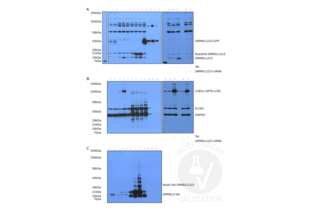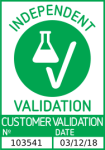ORMDL3 Antikörper (AA 53-81)
Kurzübersicht für ORMDL3 Antikörper (AA 53-81) (ABIN654696)
Target
Alle ORMDL3 Antikörper anzeigenReaktivität
Wirt
Klonalität
Konjugat
Applikation
Klon
-
-
Bindungsspezifität
- AA 53-81
-
Homologie
- B, Zf, X, Rat
-
Aufreinigung
- This antibody is purified through a protein A column, followed by peptide affinity purification.
-
Immunogen
- This ORMDL3 antibody is generated from rabbits immunized with a KLH conjugated synthetic peptide between 53-81 amino acids from the Central region of human ORMDL3.
-
Isotyp
- Ig Fraction
-
-
-
-
Applikationshinweise
- WB: 1:1000. WB: 1:1000
-
Beschränkungen
- Nur für Forschungszwecke einsetzbar
-
-
- by
- Sita Devi Gupta Ph.D., Dr Teresa M Dunn Lab, Uniformed Services University of the Health Sciences
- No.
- #103541
- Datum
- 03.12.2018
- Antigen
- ORMDL3, 1, 2
- Chargennummer
- SA100611BS
- Validierte Anwendung
- Western Blotting
- Positivkontrolle
Jurkat and HEK-293 cells for endogenous protein
Flp-In T-Rex HEK-293 cells expressing Fusion SPT on induction with Tetracycline, which in turn induces endogenous ORMDLs. (https://www.ncbi.nlm.nih.gov/pubmed/25395622)
Transient expression of NubG-HA ORMDL1, 2, or 3 in (PCR cloned from human gene expression library into yeast vector) HEK-293 cells
Transient expression of ORMDL1-GFP in HEK-293 cells
Jurkat cells stably expressing ORMDL3-HA generated using pUNO-ORMDL3-HA construct and blasticidine selection
Purified ORMDL1/2/3-GFP
- Negativkontrolle
siRNA against all the ORMDLs transfected together in Flp-In T-Rex HEK293 cells harboring Tet inducible Fusion serine palmitoyl transferase (LCB2a-ssSPTa-LCB1) SPT without and with Tet. siRNA from Dharmacon each one as ON-TARGET plus Human ORMDL1 (94101), human ORMDL2 (29095) and human ORMDL3 (94193) siRNA-SMARTpool.
- Bewertung
Passed. ABIN654696 specifically recognizes endogenous ORMDLs, transfected ORMDL1, 2, and 3 in HEK 293 cell lysates and purified ORMD1/2/3-GFP fusion proteins.
- Primärantikörper
- ABIN654696
- Sekundärantikörper
- goat anti-Rabbit IgG HRP conjugate (Bio-Rad, 170-6515, lot L005679 A)
- Full Protocol
- 293T cells:
- Grow 293T (ATCC) or Flp-In T-Rex HEK-293 (Invitrogen) cells in DMEM (ThermoFisher Scientifc, 10569044, lot 1929910) supplemented with 10% FBS (JRH Biosciences, 12103-78P, lot 4M2224) and penicillin-streptomycin (ThermoFisher Scientifc, 15140122, lot 1864852) at 37°C and 5% CO2 in 2ml on a 6 well dish to 60% confluency.
- Transfect 293T cells with 750ng NubG-HA-ORMDL1, 2, or 3 in pcDNA or ORMDL1-GFP fusion protein cloned into in pCMV6-ACGFP (Origene, RG202670) along with human LCB1, 2a and NubG-HA-ssSPTa using lipofectamine 2000 (ThermoFisher Scientific, 11668019 , lot 1959316 or 1992885) following the manufacturer´s instructions.
- Grow cells for 36h at 37°C and 5% CO2.
- Jurkat cells:
- Grow Jurkat Clone E6 (ATCC, TIB-152) and Jurkat cells stably expressing ORMDL3-HA RPMI-1640 Medium (ATCC,30-2001) supplemented with 10% FBS (JRH Biosciences, 12103-78P, lot 4M2224) at 37°C and 5% CO2 in 2ml on a 6 well dish to 60% confluency.
- Flp-In T-Rex HEK-293:
- Grow Flp-In T-Rex HEK-293 (Invitrogen) with tetracycline inducible fusion-SPT cells in DMEM (ThermoFisher Scientifc, 10569044, lot 1929910) supplemented with 10% FBS (JRH Biosciences, 12103-78P, lot 4M2224) and penicillin-streptomycin (ThermoFisher Scientifc, 15140122, lot 1864852) at 37°C and 5% CO2 in 2ml on a 6 well dish to 60% confluency.
- For tet-induction of SPT expression add 2µg/ml tetracyline.
- For ORMDLs siRNA knockdown transfect a mix of 0.8ml optiMEM (each siRNA 7.5µl from 20µM stock diluted in 0.4ml optiMEM + 15µl lipofectamine in 0.4ml optiMEM) with a final concentration of50nM of ORMDL1 (Dharmacon, 94101), ORMDL2 (Dharmacon, 29095), and ORMDL3 (Dharmacon, 94193) siRNA each into Flp-In T-Rex HEK293 cells (2.2ml optiMEM) harboring tet-inducible Fusion serine palmitoyl transferase (LCB2a-ssSPTa-LCB1) SPT using lipofectamine 2000 (ThermoFisher Scientific, 11668019, lot 1959316 or 1992885) following the manufacturer´s instructions into a final volume of 3ml. After 10h incubation, add complete DMEM media with 2µg/ml tetracycline and incubate for 46h.
- Wash cells twice with ice-cold PBS.
- Lyse 1x106 cells in 200-250µl per well cold lysis buffer: 2 volumes RIPA buffer (50mM Tris-HCl pH8, 150mM NaCl, 1% NP-40, 1% sodium deoxycholate, 0.1% SDS and 1mM EDTA) and 1 volume membrane buffer (50mM Tris-HCl pH7.5, 1mM EGTA, 30 % glycerol), protease and phosphatase inhibitors.
- Determine total protein content of the lysates using Protein Assay Dye (Bio-Rad, 5000006, lot L007096 C).
- Denature about 200µg (35µg protein for Flp-In T-Rex HEK293 cells) of total protein for 14min at 70°C in 100µl NuPAGE LDS sample buffer (ThermoFisher Scientific, NP0008, lot 736752) and subsequently separate them on a 4-12% Bis-Tris Protein Gel (ThermoFisher Scientific, NP0336BOX, lot 18092071) at 150V for 10min and 185V for 40min.
- Transfer proteins onto nitrocellulose membrane (Bio-Rad, 1620213, lot 1603053) for 2h at 85V.
- Block membrane with TBST (20mM Tris-HCl, pH7.5, 150mM NaCl with 0.1% Tween 20) and 5% Blocking-Grade Blocker (Bio-Rad, 170-6404, lot L005668 A) for 1h at RT.
- Incubation with rabbit anti-ORMDL3 (antibodies-online, ABIN654696, lot SA100611BS) diluted 1:1000 in TBST with 2% Blocking-Grade Blocker for 1h at RT.
- Wash membrane with deionized water.
- Wash membrane 3x for 10min with TBST.
- Incubation with secondary goat anti-rabbit IgG HRP conjugate (Bio-Rad, 170-6515, lot L005679 A) diluted 1:5000 in TBST with 2% Blocking-Grade Blocker for 1h at RT.
- Wash membrane with deionized water and then 4x for 10min with TBST.
- Reveal protein bands using Western Lightning Plus-ECL (PerkinElmer, NEL105001EA, lot 203-17431) on a Kodak X-OMAT 2000A processor using Radiomat LS 7980052 films (MidSci).
- Anmerkungen
ABIN654696 reveals a protein of the expected molecular weight in lysates of 293T and in Flp-In T-Rex HEK293 cells harboring Tet inducible Fusion SPT upon Tet induction. It also showed the expected size protein band in HEK-293 cells transiently transfected with ORMDL1/2 or 3 tagged recombinant plasmids and with the purified ORMDL-GFPs (GFP fusion proteins run higher due to the tag).
ABIN654696 did not detect recombinant ORMDL3-HA in total lysates from Jurkat cells stably expressing ORMDL3-HA.
ORMDL protein bands are visible in the positive samples and were significantly decreased upon knockdown using ORMDLs siRNAs. siRNA knockdown showed reduced expression of ORMDLs in uninduced and Tet induced fusion SPT cells as compared to the respective controls.
In Jurkat cells the signal is very week but longer exposure reveals the protein at the expected molecular weight. With 293T cells we see a stronger band just above 21kDa. This band was absent in Jurkat cells and in the purified proteins.
Validierung #103541 (Western Blotting)![Erfolgreich validiert 'Independent Validation' Siegel]()
![Erfolgreich validiert 'Independent Validation' Siegel]() Validierungsbilder
Validierungsbilder![A. Western blot analysis using ABIN654696 of ORMDL1, ORMDL2 and ORMDL3 expression in total lysates from Jurkat cells (1), Jurkat cells stably expressing ORMDL3-HA (2), Flp-In T-Rex HEK293 cells with fusion SPT without and with tetracycline (3 and 4), 293T cells with pcDNA3.1 (5), HEK cells with NubG-HA tagged ORMDL1 (6), 2 (7) or 3 (8), transiently transfected with pCMVAC-ORMDL1-GFP (9), and purified ORMDL1-GFP (10), ORMDL2-GFP (11) and ORMDL3-GFP (12). ORMDLs siRNA expression decreases endogenous ORMDLs protein in uninduced cells and in Flp-In T-Rex HEK293 cells harboring tet inducible SPT as revealed by western blot using ABIN654696 on lysates from Flp-In T-Rex HEK293 cells harboring Tet inducible SPT without Tet (13, 14) and with Tet (15) and all without siRNAs compared to cell lysates subsequently to siRNA ORMDL1, 2, and 3 knockdown without (16) or with Tet induction (17). B. Western blot analysis of the same lysates using anti-human LCB1 and GAPDH antibodies and C. an anti-HA antibody.]() A. Western blot analysis using ABIN654696 of ORMDL1, ORMDL2 and ORMDL3 expression in total lysates from Jurkat cells (1), Jurkat cells stably expressing ORMDL3-HA (2), Flp-In T-Rex HEK293 cells with fusion SPT without and with tetracycline (3 and 4), 293T cells with pcDNA3.1 (5), HEK cells with NubG-HA tagged ORMDL1 (6), 2 (7) or 3 (8), transiently transfected with pCMVAC-ORMDL1-GFP (9), and purified ORMDL1-GFP (10), ORMDL2-GFP (11) and ORMDL3-GFP (12). ORMDLs siRNA expression decreases endogenous ORMDLs protein in uninduced cells and in Flp-In T-Rex HEK293 cells harboring tet inducible SPT as revealed by western blot using ABIN654696 on lysates from Flp-In T-Rex HEK293 cells harboring Tet inducible SPT without Tet (13, 14) and with Tet (15) and all without siRNAs compared to cell lysates subsequently to siRNA ORMDL1, 2, and 3 knockdown without (16) or with Tet induction (17). B. Western blot analysis of the same lysates using anti-human LCB1 and GAPDH antibodies and C. an anti-HA antibody.
Protokoll
A. Western blot analysis using ABIN654696 of ORMDL1, ORMDL2 and ORMDL3 expression in total lysates from Jurkat cells (1), Jurkat cells stably expressing ORMDL3-HA (2), Flp-In T-Rex HEK293 cells with fusion SPT without and with tetracycline (3 and 4), 293T cells with pcDNA3.1 (5), HEK cells with NubG-HA tagged ORMDL1 (6), 2 (7) or 3 (8), transiently transfected with pCMVAC-ORMDL1-GFP (9), and purified ORMDL1-GFP (10), ORMDL2-GFP (11) and ORMDL3-GFP (12). ORMDLs siRNA expression decreases endogenous ORMDLs protein in uninduced cells and in Flp-In T-Rex HEK293 cells harboring tet inducible SPT as revealed by western blot using ABIN654696 on lysates from Flp-In T-Rex HEK293 cells harboring Tet inducible SPT without Tet (13, 14) and with Tet (15) and all without siRNAs compared to cell lysates subsequently to siRNA ORMDL1, 2, and 3 knockdown without (16) or with Tet induction (17). B. Western blot analysis of the same lysates using anti-human LCB1 and GAPDH antibodies and C. an anti-HA antibody.
Protokoll -
-
Format
- Liquid
-
Buffer
- Purified polyclonal antibody supplied in PBS with 0.09 % (W/V) sodium azide.
-
Konservierungsmittel
- Sodium azide
-
Vorsichtsmaßnahmen
- This product contains Sodium azide: a POISONOUS AND HAZARDOUS SUBSTANCE which should be handled by trained staff only.
-
Handhabung
- Avoid freeze-thaw cycles.
-
Lagerung
- 4 °C,-20 °C
-
Informationen zur Lagerung
- Maintain refrigerated at 2-8 °C for up to 6 months. For long term storage store at -20 °C in small aliquots.
-
Haltbarkeit
- 6 months
-
-
-
: "Staurosporines decrease ORMDL proteins and enhance sphingomyelin synthesis resulting in depletion of plasmalemmal phosphatidylserine." in: Scientific reports, Vol. 6, pp. 35762, (2018) (PubMed).
: "ORMDL proteins regulate ceramide levels during sterile inflammation." in: Journal of lipid research, Vol. 57, Issue 8, pp. 1412-22, (2017) (PubMed).
: "ORMDL3 modulates store-operated calcium entry and lymphocyte activation." in: Human molecular genetics, Vol. 22, Issue 3, pp. 519-30, (2013) (PubMed).
: "ORMDL3 is an inducible lung epithelial gene regulating metalloproteases, chemokines, OAS, and ATF6." in: Proceedings of the National Academy of Sciences of the United States of America, Vol. 109, Issue 41, pp. 16648-53, (2012) (PubMed).
-
: "Staurosporines decrease ORMDL proteins and enhance sphingomyelin synthesis resulting in depletion of plasmalemmal phosphatidylserine." in: Scientific reports, Vol. 6, pp. 35762, (2018) (PubMed).
-
-


 (4 Referenzen)
(4 Referenzen) (1 Validierung)
(1 Validierung)



